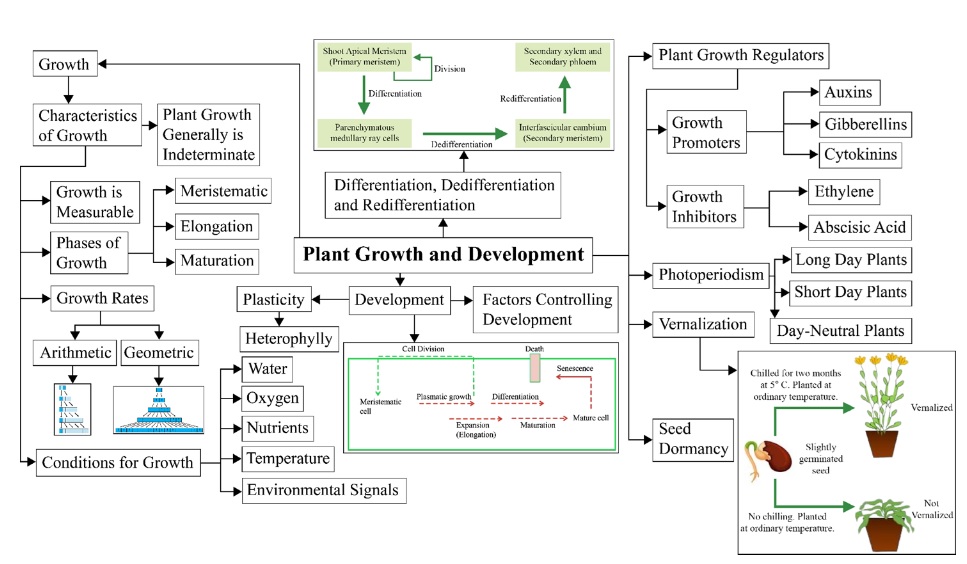Explore Vedantu's Plant Growth And Development Class 11 Questions And Answers For Complete Understanding
FAQs on NCERT Solutions For Class 11 Biology Chapter 13 Plant Growth And Development
1. What is the CBSE-approved, stepwise method to solve Exercise questions in Class 11 Biology Chapter 13 Plant Growth and Development?
The CBSE-approved, stepwise method for solving Exercise questions in Class 11 Biology Chapter 13 involves reading each question carefully, understanding the keywords, referencing the related NCERT textbook content, and forming answers as per the official NCERT answer format. Each response should use accurate biological terminology, address all question parts directly, and be structured clearly, as per the CBSE 2025–26 guidelines.
2. Are the NCERT Solutions for Class 11 Biology Chapter 13 Plant Growth and Development provided here in accordance with the 2025–26 CBSE Syllabus?
Yes, all answers given in the NCERT Solutions for Class 11 Biology Chapter 13 are fully aligned with the updated CBSE 2025–26 syllabus and follow the official NCERT textbook answer structure, ensuring you cover all exercise and intext questions as prescribed.
3. How can I access or download the NCERT solutions for Class 11 Biology Chapter 13 Plant Growth and Development in free PDF format?
You can quickly access or download free PDF versions of NCERT Solutions for Class 11 Biology Chapter 13 Plant Growth and Development from official educational platforms like Vedantu, where the solutions are presented in CBSE-approved, stepwise formats suitable for exam preparation.
4. How does the NCERT answer key for Class 11 Biology Chapter 13 ensure correct and complete answers for board preparations?
The NCERT answer key for this chapter is crafted to provide stepwise and complete answers, directly referencing the NCERT textbook content, explaining core concepts, and strictly following the CBSE marking scheme so students gain full marks in examinations.
5. What is the best strategy for framing textbook answers for conceptual questions in Plant Growth and Development according to NCERT?
The best strategy for answering conceptual questions is to stick to the exact terminology used in the NCERT textbook, include clear, logical explanations, and structure your answer in precise steps—introduction, explanation, and conclusion—reflecting the CBSE exam answer style.
6. Will the Class 11 Biology Chapter 13 NCERT Questions and Answers help in competitive exams like NEET?
Yes, the NCERT Solutions for Class 11 Biology Chapter 13 provide strong conceptual clarity as they closely follow the NCERT curriculum, which is essential for NEET and other competitive exams, as questions in these exams are often based directly on NCERT patterns.
7. What is the correct NCERT answer format for diagram-based questions in Chapter 13 Plant Growth and Development?
For diagram-based questions, students should draw neat, well-labelled diagrams as per the NCERT textbook, accompany the diagram with a stepwise explanation, and ensure all parts relevant to the question are mentioned in both drawing and description, matching CBSE-approved answers.
8. How does one solve assertion-reason or match-the-pair type exercise questions in Plant Growth and Development using the NCERT Solutions?
Assertion-Reason and Match-the-Pair questions should be solved by carefully reading each statement, cross-verifying with the NCERT textbook information, providing clear reasoning or matching as required, and justifying your answer stepwise as outlined in official NCERT solutions.
9. Are all intext and back exercise questions from Class 11 Biology Chapter 13 solved here using the official NCERT pattern?
Yes, each intext and back exercise question is solved in a detailed stepwise manner, strictly following the official NCERT answer pattern and ensuring the response is suitable for scoring full marks as per CBSE guidelines.
10. What common mistakes should be avoided while writing CBSE-approved answers for Class 11 Biology Chapter 13 Plant Growth and Development?
To avoid losing marks, do not use informal language, always use NCERT-approved terminology, don't skip steps in explanations, and ensure both diagrams and definitions are included where necessary. Always proofread your answers for completeness and accuracy as per the CBSE exam pattern.
11. Why is the use of NCERT language important while solving Plant Growth and Development Class 11 Biology questions?
Using NCERT language helps ensure that answers are accurate, concise, and directly in line with what CBSE examiners expect, reducing the chance of missing marks for incorrect phrasing or missing keywords as per the NCERT format.
12. Can these NCERT Solutions for Chapter 13 be used for quick revision before exams?
Absolutely, these NCERT Solutions for Class 11 Biology Chapter 13 are structured for direct revision, providing textbook-aligned, stepwise answers that make last-minute exam preparation efficient and CBSE-focused.



























